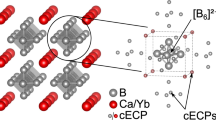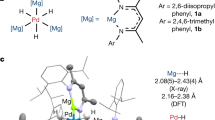Abstract
THE bonding in the Mo6Cl84+ and Ta6Cl122+ cations, both of which contain an octahedron of metal atoms, has recently been rationalized in terms of a 40-electron model1. The edges of the metal octahedron define the orientation of twelve bonds (type A) while the faces of the octahedron define the position of another eight (type B). In Mo6Cl84+ twenty-four metal electrons fill the A orbitals and sixteen chlorine σ electrons fill type B. In Ta6Cl122+ the roles of the sixteen metal and twenty-four chlorine σ electrons are interchanged. It is now possible to speculate on the occurrence of other metal octahedra if we require that this 40-electron rule be obeyed.
This is a preview of subscription content, access via your institution
Access options
Subscribe to this journal
Receive 51 print issues and online access
$199.00 per year
only $3.90 per issue
Buy this article
- Purchase on Springer Link
- Instant access to full article PDF
Prices may be subject to local taxes which are calculated during checkout
Similar content being viewed by others
References
Kettle, S. F. A., Theoret. Chim. Acta, 3, 211 (1965).
Wöhler, L., and Müller, W., Z. Anorg. Chem., 149, 125 (1925).
Author information
Authors and Affiliations
Rights and permissions
About this article
Cite this article
KETTLE, S. Octahedral Metal Clusters. Nature 207, 1384–1385 (1965). https://doi.org/10.1038/2071384b0
Published:
Issue Date:
DOI: https://doi.org/10.1038/2071384b0
This article is cited by
-
A topological equivalent-orbital approach to the bonding in some tetrahedral molecules
Theoretica Chimica Acta (1966)
Comments
By submitting a comment you agree to abide by our Terms and Community Guidelines. If you find something abusive or that does not comply with our terms or guidelines please flag it as inappropriate.



